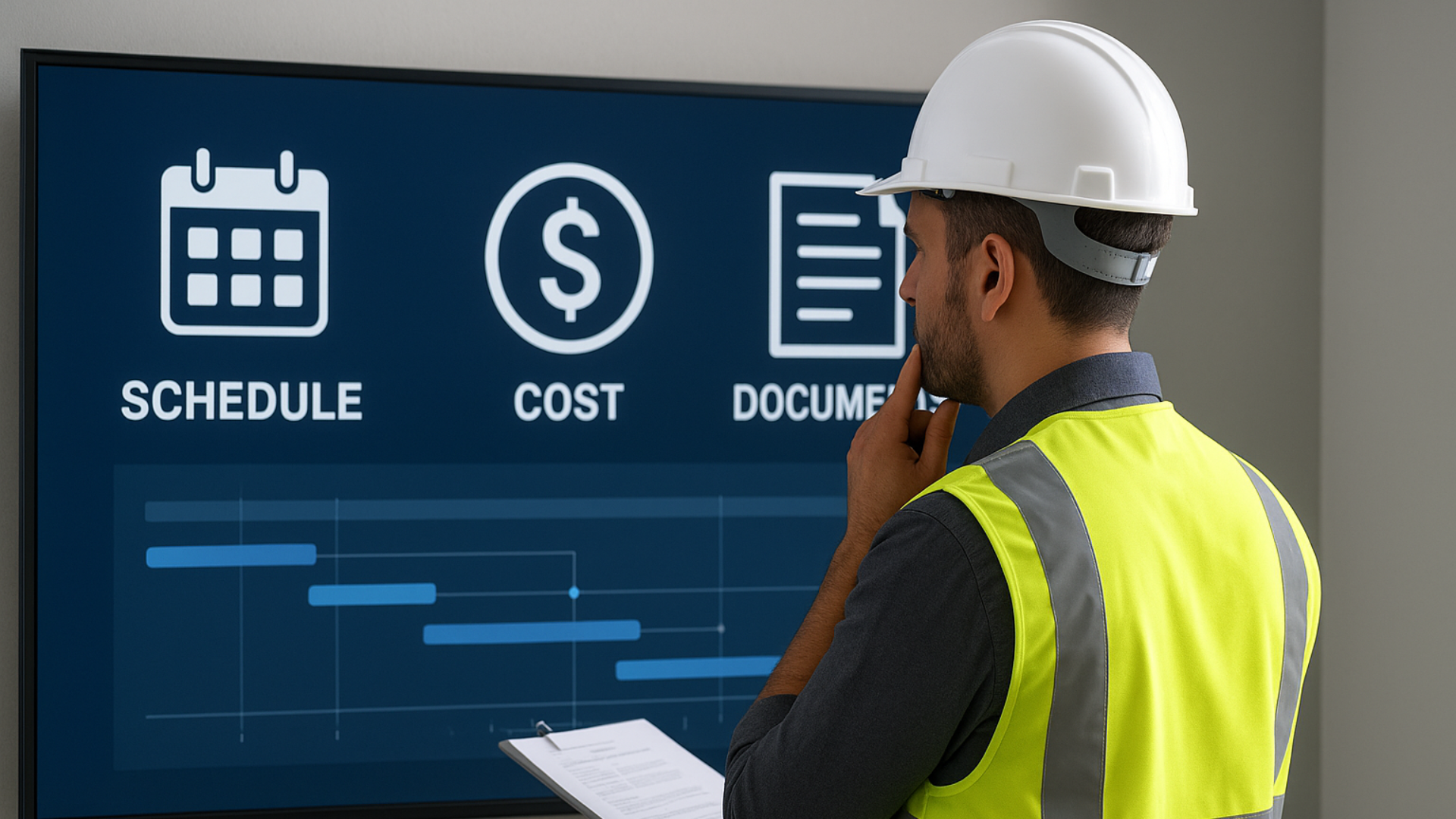Managing a construction project is rarely about just the build. It’s the endless updates, budget checks, and documents that pile up along the way.
Many contractors find themselves lost in spreadsheets, emails, and half a dozen apps just to keep everyone on the same page. It works… until it doesn’t.
That’s why more teams are looking for software that brings everything into one place. When done right, it saves hours, cuts down on errors, and gives project managers the breathing room to focus on the actual work.
10 Essential Features in Construction Project Management Software for Contractors
Software shouldn’t slow down a construction project; it should give you a clear view of schedules, budgets, and tasks without the constant back-and-forth.
The features that matter most are the ones you’ll use every single day. Here are 10 essentials worth looking for before you commit to any construction project management software.
Key Takeaways
- Look for construction project management software that helps you run projects smoothly, not add extra work.
- Scheduling, budgeting, and document management are the backbone of any useful platform.
- Real-time updates, punch lists, and reporting keep teams aligned and projects moving.
- The right choice gives general contractors one platform to manage people, paperwork, and progress.
Why Choosing the Right Construction Project Management Software Matters

Good software gives you clarity where confusion usually hides, cost overruns flagged before they bite, task owners who actually close out work, and a single source for the latest drawings.
- Fewer Costly Mistakes: When schedules, budgets, and change orders live in one place, there’s less risk of oversights that lead to expensive rework.
- Real-Time Accountability: Task owners see exactly what’s due and when, making it harder for critical items to slip through the cracks.
- Faster Decisions On Site: With live updates, project managers and crews don’t wait around for the latest drawings or approvals. Work keeps moving.
- Stronger Team Coordination: Instead of managing multiple apps and emails, everyone works from the same system, which keeps communication clear and consistent.
For an in-depth dive, read: Project Management for Construction Teams: A 2025 Overview
10 Must-Have Features in Construction Project Management Software
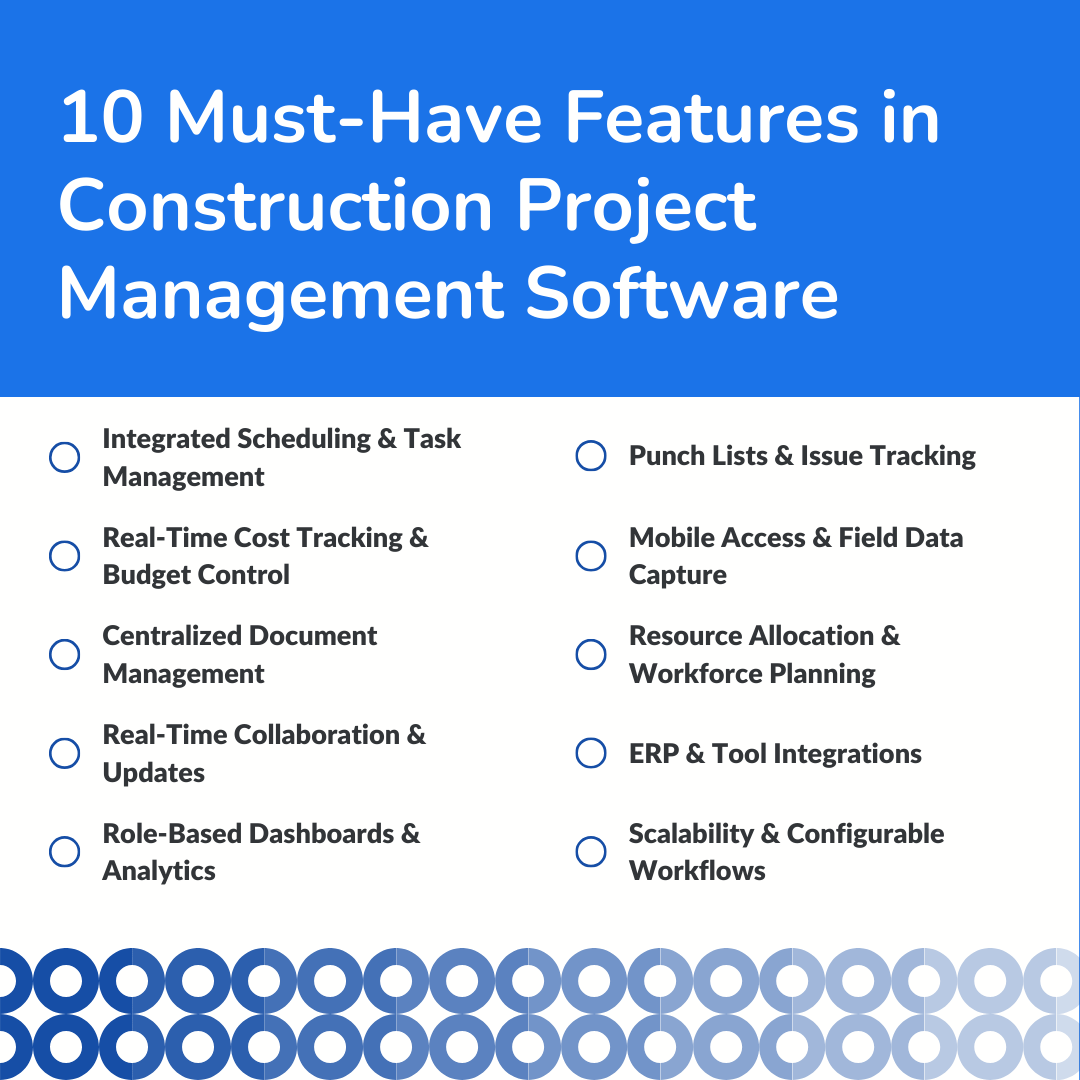
Below is the list of essential features your construction management software needs to have for better workflow:
1. Integrated Scheduling and Task Management
What it is: a single scheduling system that links tasks, deadlines, and what needs to happen first, across the project.
What to look for: task order mapping, automated notifications, drag-and-drop rescheduling, critical path visualization, and recurring task templates. You should also verify that schedule changes propagate to mobile users and downstream systems (e.g., procurement) immediately.
Why it matters: Tightly managed task orders prevent trade clashes and cut standby time. This helps teams get automatic alerts for changed dates and a live critical path so managers can re-sequence work before delays stack.
Real-world example: On one commercial build, the drywall crew arrived while electrical work was still incomplete, forcing two days of downtime and extra labor costs. After moving to a centralized scheduling system, the contractor could map out task order dependencies, spot clashes in advance, and adjust the plan before crews were mobilized. That simple visibility cut wasted time and kept subsequent trades on schedule.
Check out: 5 Strategies to Prevent Construction Project Delays
2. Real-Time Cost Tracking and Budget Control
What it is: Live tracking of committed costs, actual spend, and forecasted burn versus budgets.
What to look for: Job-level cost breakdowns, PO and invoice sync, daily cost feeds, variance alerts, and forecasting based on trends. You should also check whether the software supports committed vs. incurred cost views and rolling forecasts.
Why it matters: Early detection of overruns preserves margins. The right tool ties POs and invoices to budget lines and sends threshold alerts so project teams can correct course rather than discover gaps at month-end.
Real-world example: A regional builder only realized concrete costs had exceeded estimates once the monthly report was closed. By then, the overrun had eaten into margins. With real-time tracking, site supervisors log expenses daily and managers receive alerts instantly, allowing budget adjustments before losses accumulate.
3. Centralized Document Management
What it is: One secure place for drawings, specs, RFIs, submittals, change orders, and contracts with complete version control.
What to look for: Version history, search by metadata, controlled access, approval workflows, and offline mobile sync. You should also confirm file size limits, BIM and CAD support, and integration with email and cloud storage for automatic file import.
Why it matters: Ensuring everyone uses the latest drawings removes rework risk. Strong document management reduces time spent searching, simplifies audits, and enforces approvals.
Real-world example: On one project, a subcontractor installed work based on an outdated drawing retrieved from email rather than the latest revision. The resulting rework increased both cost and delay. But Centralized document management ensured teams always have access to the current version, preventing costly mistakes and disputes.
4. Real-Time Collaboration and Updates
What it is: A unified workspace where office staff, subs, and field crews exchange updates, approvals, and comments instantly.
What to look for: Threaded comments on documents/tasks, inline markup, approval routing, mention/assign features, and push notifications.
Why it matters: Instant collaboration shortens approval cycles and reduces miscommunication that stalls work. Look for activity stamps and the ability to convert messages into actionable tasks so communications don’t become lost information.
Real-world example: A site needed approval for a change order, but waited three days for an email response from the office. But when they used real-time collaboration, approvals happened directly in the system, cutting the turnaround to hours and keeping crews moving without extended stoppages.
5. Role-Based Dashboards and Analytics
What it is: Configurable dashboards that surface relevant KPIs for PMs, finance, site supervisors, and owners.
What to look for: Customizable widgets, drill-downs from summary to line-item detail, scheduled reports, and exportable datasets. Also, ensure that dashboards support alerts and can be scheduled or embedded in status emails.
Why it matters: Stakeholders need specific views and not one giant report. Role-based dashboards speed decision-making by presenting the right metrics (budget variance for finance, task completion for PMs).
Real-world example: On a large project, finance needed daily cost reports while supervisors only cared about task completion. With one-size-fits-all reporting, both groups spent time sifting through irrelevant data. However, when they later utilized role-based dashboards, each stakeholder now receives the metrics they need, saving hours of manual filtering.
6. Punch Lists and Issue Tracking
What it is: A field-first system to record, assign, and close defects with photos, timestamps, and owner assignments.
What to look for: Photo and video attachments, priority flags, reassign workflow, status history, and completion proof. You should also confirm you can filter by trade, location, or deadline and export closure evidence for client sign-offs.
Why it matters: Systematic punch lists accelerate closeouts and reduce warranty disputes. Track response SLAs and generate punch-list reports for handover.
Real-world example: At handover, inspectors flagged dozens of incomplete items, but tracking them on paper led to missed fixes and frustrated clients. Once they switched to digital punch lists, they could log issues with photos, assign them to the right trades, and close them in order. It sped up final approvals and kept the clients happy.
7. Mobile Access and Field Data Capture
What it is: A mobile app or responsive interface that lets crews submit updates, inspections, timesheets, and photos from the site.
What to look for: Offline mode, quick forms, barcode/QR scanning for inventory, geotagged photos, and push alerts. You should also verify platform parity (iOS/Android) and how the app performs in low-connectivity environments.
Why it matters: Data captured at the source is more accurate and timely. Mobile capture reduces admin lag, improves safety reporting, and powers real-time dashboards.
Real-world example: A foreman kept daily logs on paper and later entered them into the office system, often missing details. By using mobile capture directly on-site, updates, photos, and notes went straight into the system in real time. That immediacy improved accuracy and gave live visibility into how the project was progressing.
8. Resource Allocation and Workforce Planning
What it is: Tools to plan labor, crews, equipment, and material deployments across projects and weeks.
What to look for: Resource calendars, utilization reports, shift scheduling, skill tagging, and conflict detection. You should also verify that the system surfaces long-lead resource needs and integrates with timesheets for accurate costing.
Why it matters: Optimized allocation cuts downtime and prevents double-booking expensive equipment. Use utilization metrics to reassign underused crews or justify subcontractor hires.
Real-world example: Two crews were unknowingly scheduled for the same piece of equipment, leading to idle labor. After implementing workforce planning tools, managers now see equipment assignments across projects and reallocate before clashes occur, keeping both crews productive and costs under control.
9. ERP and Tool Integrations
What it is: Bi-directional connectors between your project management system and accounting, ERP, procurement, and design tools.
What to look for: Native connectors for major ERPs, open APIs, automated PO/invoice sync, and mapped field-to-ledger workflows. You should also confirm how conflicts are resolved and whether integrations support staged syncs for large data sets.
Why it matters: Integrations eliminate duplicate entry and ensure financials reflect project reality. A reliable source of communication between PM and finance accelerates closeout and cash flow management.
Real-world example: A contractor’s accounting system and project management tool weren’t connected, requiring duplicate invoice entries. Errors created mismatched financials. Integrating ERP with the project platform eliminated double entry, reduced mistakes, and provided consistent cost visibility across both systems.
Learn How Top Builders Track Change Orders Efficiently
10. Scalability and Configurable Workflows
What it is: A system that supports more projects, users, and custom workflows without heavy redevelopment.
What to look for: Multi-company support, role/permission granularity, template libraries, API access, and configurable approval chains. You should also confirm customer limits, performance SLAs, and admin controls for governance.
Why it matters: A platform that scales prevents costly migrations as your business grows. Configurable workflows let contractors model real operational steps, approvals, change-order routing, subcontractor access, so the software follows your process, not the other way round.
Real-world example: A small contractor grew quickly but outgrew their original software, forcing an expensive system switch. Choosing a scalable platform with configurable workflows allowed them to add projects, teams, and approval steps without disruption, supporting growth without reimplementation costs.
How to Choose the Right Construction Project Management Software
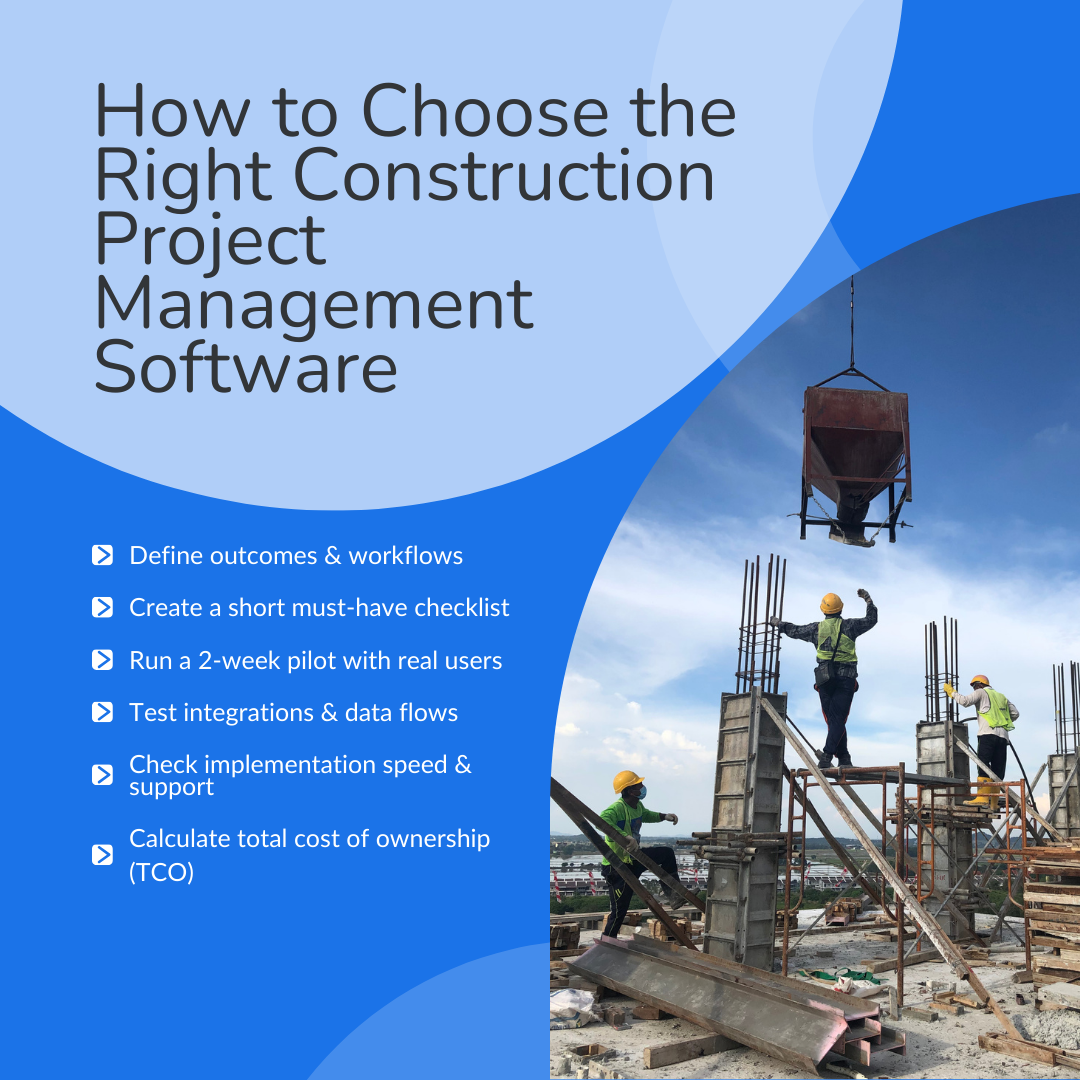
Choose a short decision framework that matches software capabilities to how your team actually works. Below are concrete steps you can follow during evaluation.
1. Define outcomes and workflows (15–30 mins)
- List the 3–5 outcomes you need the software to deliver (e.g., reduce schedule clashes, stop cost overruns, speed handovers).
- Map one representative workflow for each outcome (what needs to happen first → who updates → how approvals flow).
2. Create a short ‘must-have’ checklist (10 items max)
- Use "our feature" headings as the checklist: scheduling (task order), real-time cost tracking, document control, mobile capture, integrations, punch lists, dashboards, resource planning, ERP connectors, and scalability.
- Mark each item as: Critical / Good-to-have / Optional.
3. Run a 2-week hands-on pilot with real users
- Give your PM, one foreman, and a finance lead access to the system with a live project or a staged trial.
- Measure: time to complete daily updates, number of version errors, and time spent compiling reports.
4. Test integrations and data flows
- Verify PO/invoice sync with accounting, schedule handoffs with procurement, and field updates flowing to dashboards. Simulate exception cases (partial sync, duplicate invoice) and confirm conflict handling.
5. Check implementation speed and vendor support
- Ask for a typical rollout timeline and a named customer success contact. Confirm training resources and SLAs for issue response.
6. Calculate total cost of ownership (TCO)
- Include subscription, implementation, training, integrations, and expected admin time. Compare TCO against projected time/cost savings over 12–24 months.
Common Pitfalls to Avoid
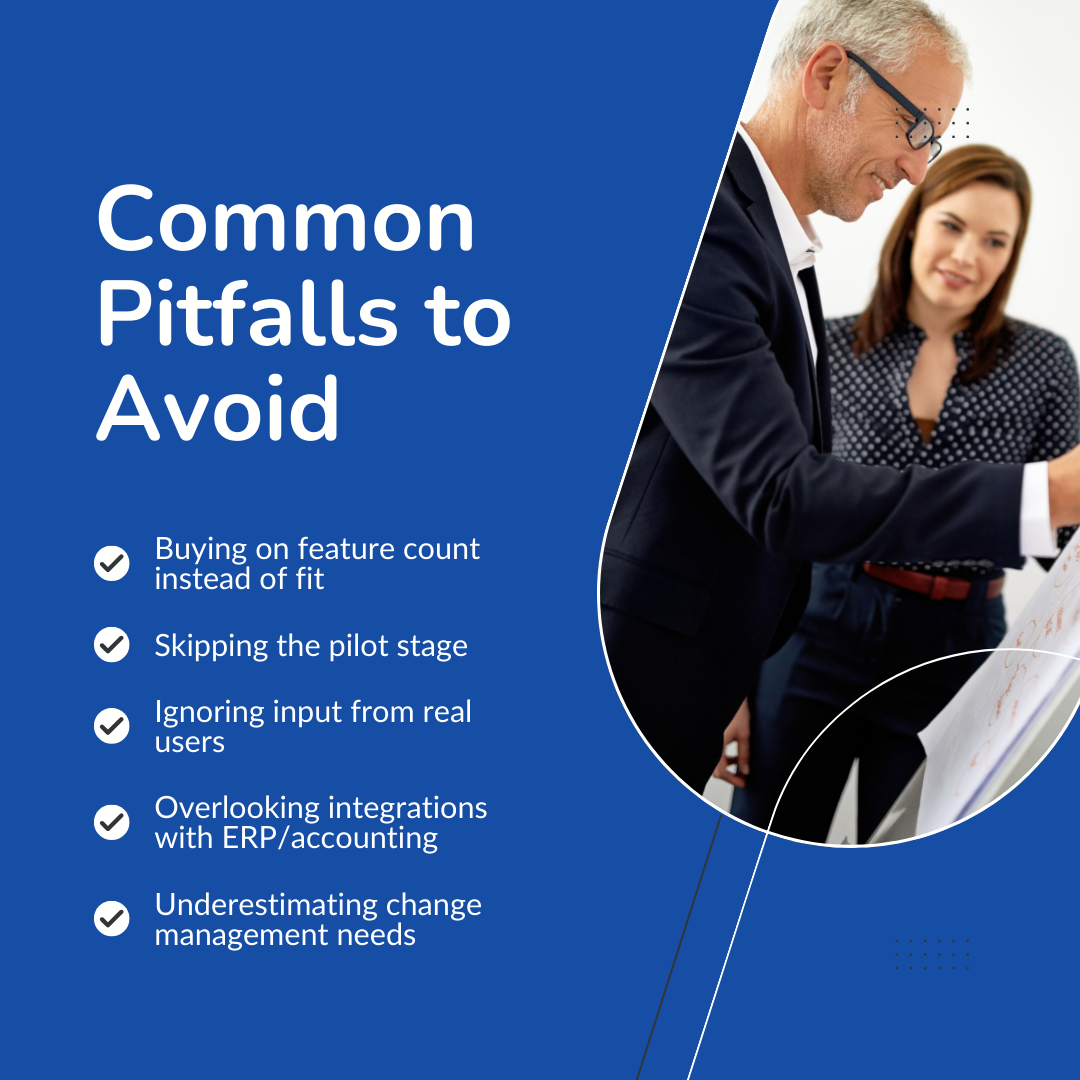
1. Buying on feature count instead of fit:
Just because a software boasts a hundred features doesn’t mean it’s the right fit for your team. A longer checklist often means more complexity, not more value.
Therefore, focus on what your team actually needs day-to-day, not what looks shiny on a brochure.
2. Skipping the pilot
Demos can be deceiving as they show a perfect scenario, but the real test is in the trenches.
A pilot lets your team try the software in actual workflows, uncover hidden bottlenecks, and see if it truly solves problems or creates new headaches.
3. Ignoring real users
If your foremen, project managers, or techs hate the app, it won’t stick.
Involving the people who use it daily ensures adoption, highlights practical challenges, and makes everyone feel heard.
4. Overlooking integrations
Missing links to ERP, accounting, or inventory systems can turn your “smart” software into a data-entry nightmare.
Without proper integration, you’ll end up entering information twice, chasing stale numbers, and creating avoidable errors.
5. Underestimating change management
Software doesn’t run itself. Teams need time, training, and clear guidance to embrace new tools.
Allocate budget and schedule for onboarding, process updates, and ongoing support; it’s the difference between a smooth transition and chaos.
Why ConstructionBase Is the One Platform You Need
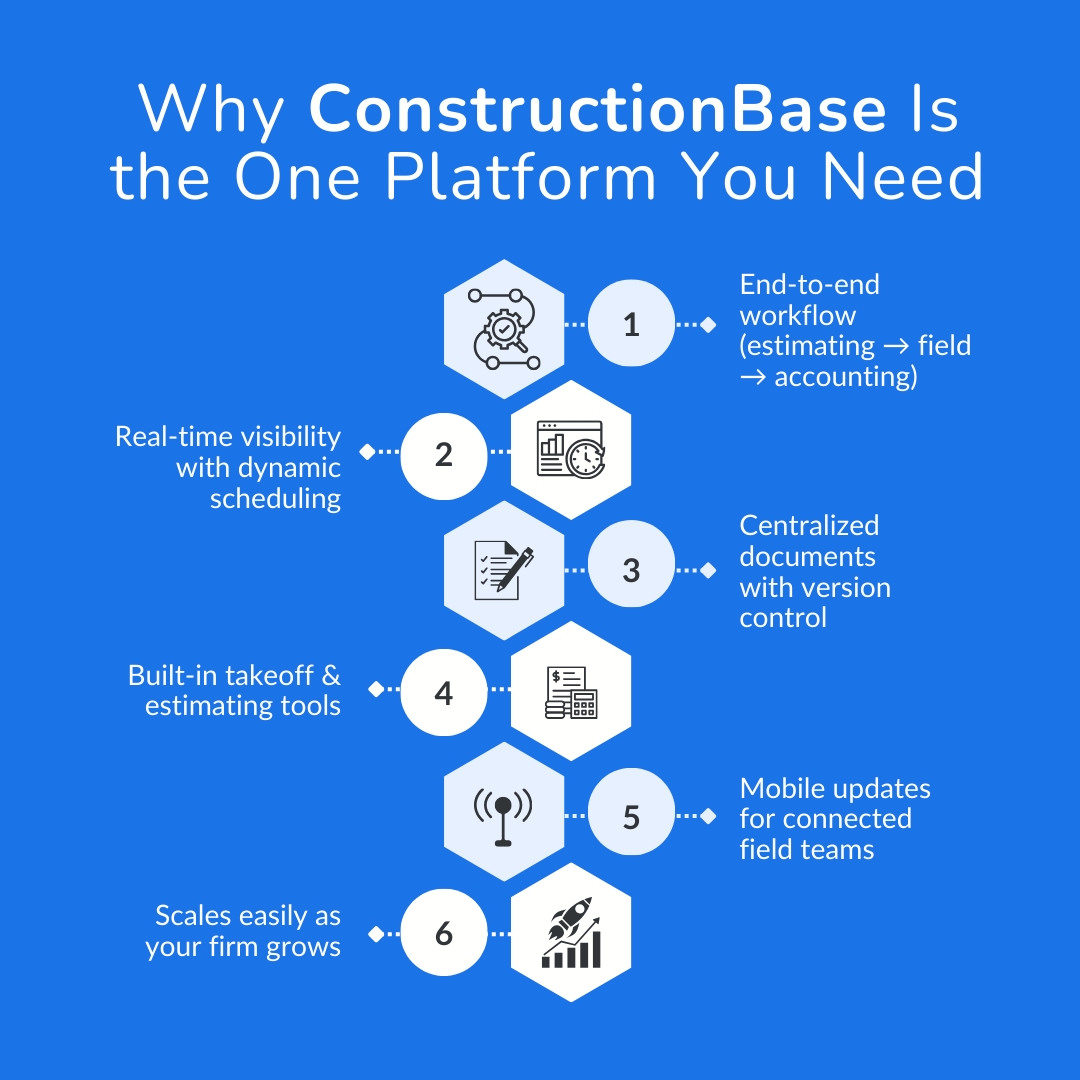
Most tools cover one slice of construction management, scheduling, estimating, or documents, but leave gaps that teams must patch with extra apps.
ConstructionBase brings those essentials together in a single system built for contractors.
- End-to-end workflow: from estimating and takeoffs to scheduling, field management, and accounting.
- Real-time visibility: dynamic scheduling and live project tracking keep managers ahead of delays and overruns.
- Centralized documents: contracts, change orders, and drawings live in one place with version control.
- Accurate estimating: built-in takeoff and bidding tools improve margins and speed up proposals.
- Connected field teams: mobile access lets crews update progress and issues on site.
- Scalable growth: the platform adapts as your firm adds projects, users, and reporting needs.
- Streamlined communication: Built-in messaging and comments connect office staff, field teams, and clients in one place.
- Smart analytics and reporting: Turns raw project data into visual, easy-to-read reports on budgets.
- Automated alerts and notifications: Keep your team ahead of deadlines, approvals, and change requests with real-time reminders.
By consolidating core functions into one platform, ConstructionBase reduces duplication, simplifies adoption, and keeps your projects moving with fewer headaches.
Conclusion
The right construction project management software is more than a checklist of features. It’s the tool that will shape how efficiently your projects run, how accurately costs are controlled, and how effectively teams collaborate in the field.
By focusing on the ten essential features outlined above and applying a structured selection process, contractors can avoid common pitfalls and choose a platform that supports growth instead of holding it back.
The Next Step: ConstructionBase
You’ve seen the features that matter most in construction project management software and the pitfalls to avoid when choosing. Now it’s time to put that knowledge into action.
Book a demo with ConstructionBase and see how one platform brings scheduling, cost control, document management, and field updates together.
FAQs
Q1. What is construction project management software?
Software that helps contractors plan, manage, and track construction processes and projects in real time.
Q2. What features are most important in construction management software?
Scheduling, budgeting, document management, punch lists, and collaboration tools are essential for a smooth workflow .
Q3. Do general contractors really need one platform?
Yes, using one platform for project teams reduces confusion and improves efficiency.
Have questions or need personalized advice?
Talk to an Expert Today and let our construction specialists guide you to success.

